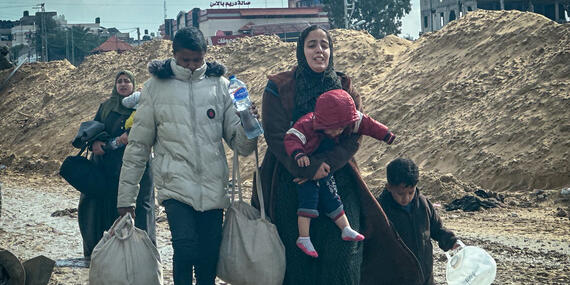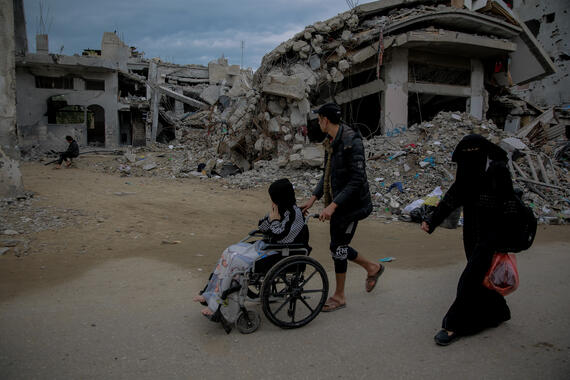Gaza: “I cannot take any more deaths. I’ve lost too many loved ones.”

Olga Cherevko was part of a four-person OCHA team that travelled to the Gaza Strip in January to support the response to its unprecedented humanitarian crisis. Here, Olga describes her experiences and the unbearable reality that millions of people in Gaza face each day.
On a sunny January morning in Gaza, one small stretch of the Strip’s coastal road seems ordinary, mundane: children play on the beach; adults stroll, daydream, chat and laugh; camels pensively chew sunburned grass.
The children’s laughter almost drowns out the sounds of war planes and explosions that punctuate the air day and night. If one looks away from the sea, sprawling rows of tents, some neatly organized, some haphazardly put together, line the streets as donkeys pull carts full of people and their belongings. Many more people are on foot, also clearly on the move, in search of safety, food or water.
I previously worked for UNRWA [UN Agency for Palestine Refugees] in Gaza, from 2014 to 2017, and this was my first time returning to Gaza since then. But the tragic circumstances made this mission surreal.
Even getting into Gaza was difficult. We entered through the Rafah border crossing between Gaza and Egypt, which is the only passenger crossing that remains open today. We left Cairo at 5 a.m., and after a long and tedious journey with multiple checkpoints along the way, we finally entered Gaza at around 7 p.m. that day.
I was relieved to see many familiar faces of former colleagues, though many had aged beyond their years. They’ve lived through years of unimaginable suffering, many having lost multiple family members in this or previous escalations in fighting. Yet somehow they found a way to smile through the pain.
Today, there is no safe place in Gaza. Everywhere, people talk about being worried for their safety, about the uncertainty of the future and what Gaza will look like in the months to come.
Entering Gaza City for the first time was shocking. The area where I lived in 2014 was unrecognizable. Nothing that I remembered was left. The beautiful port, the neighbourhood shop, and the mosque rebuilt several times after being destroyed over the years of fighting were now just piles of ruins. Iron stuck out of the pieces of concrete that were once someone’s home – places put together lovingly and carefully, and where perhaps someone hoped to see their children grow, graduate, dream.
Mai is the mother of four-year-old Yusef, who has a serious heart condition. When I asked her what she wished for, she replied:
“I wish to return to my home, but I know there is nothing to return to.”

Displaced and bombarded as the world watches
Now in its sixth month, this war shows no signs of abating. More than 30,000 people have been reported killed, with more than 71,000 injured, most of them women and children. Many more remain buried under the rubble as constant bombardments destroy more buildings and kill and injure civilians daily.
More than 50 per cent of the population of the Gaza Strip has been squeezed into the ever-shrinking space that is Rafah. Evacuation orders continue, as more and more families are forced to flee in search of safety.
When I worked for UNRWA, Rafah was my “area of responsibility.” My colleague and I would visit every UNRWA installation and speak to people in schools, health facilities and aid distribution points.
Back in 2014, after one of the most intense escalations, which lasted for 51 days, people were exhausted, traumatized and looking for answers. The only thing everyone knew was that this would happen again and again unless a meaningful political solution was found.
Fast forward to today, Um Mohammed had to flee Gaza City when her house there was destroyed. She and her family of nine (her husband, two sons, their wives and four grandchildren) have moved four times throughout the Strip and currently live in an informal shelter in Rafah. Seven adults are sleeping in one tent – a luxury compared to the conditions of some other sites, where as many as five families are crammed into one tent.
“This is the best diet, we’ve all lost weight without the gym,” she jokes. With food in short supply, every person in Gaza is now food insecure, and one in every four is on the edge of starving.
Read the entire story on Exposure.
